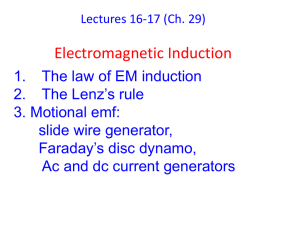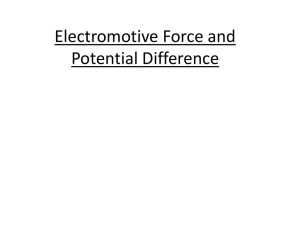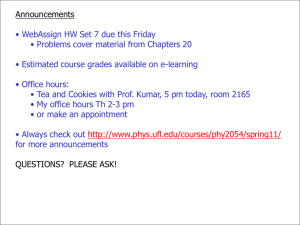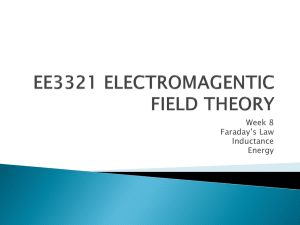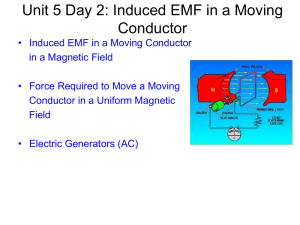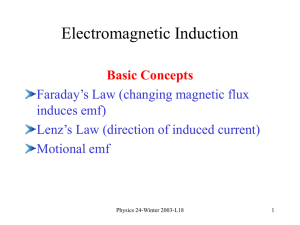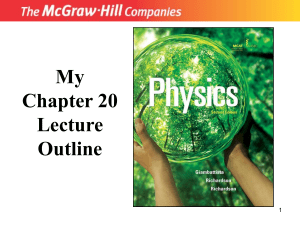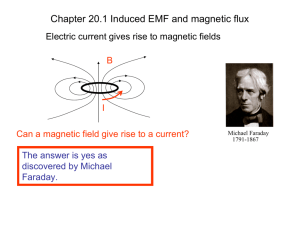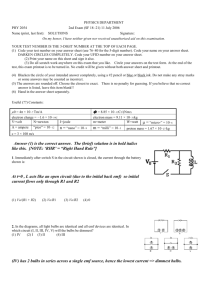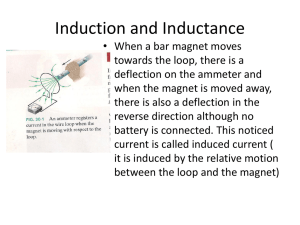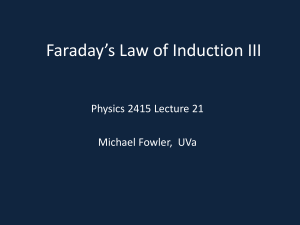PHY2054_03-03
advertisement
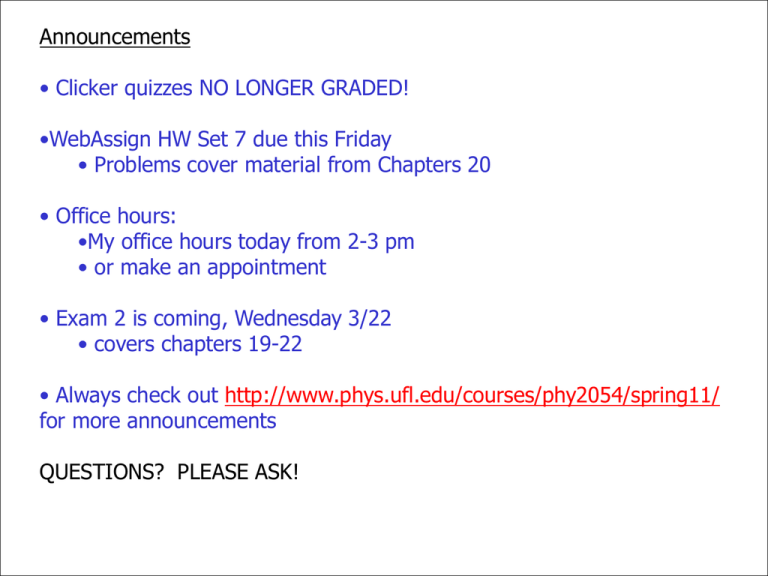
Announcements • Clicker quizzes NO LONGER GRADED! •WebAssign HW Set 7 due this Friday • Problems cover material from Chapters 20 • Office hours: •My office hours today from 2-3 pm • or make an appointment • Exam 2 is coming, Wednesday 3/22 • covers chapters 19-22 • Always check out http://www.phys.ufl.edu/courses/phy2054/spring11/ for more announcements QUESTIONS? PLEASE ASK! From last time… Magnetic Flux ΦB = BA = B A cos θ Faraday’s Law: instantaneous emf induced in a circuit = time rate of change of magnetic flux through the circuit e = -N DF B Dt Lenz’s Law:induced emf travels in the direction that creates a magnetic field with flux opposing the change in the original flux through the circuit Motional emf: ε= B ℓ v Motional EMF in a Circuit Now place the conductor on a pair of rails and pull it with an applied force Fapp assume the moving bar has negligible resistance The magnetic force Fapp on the charges sets up an induced current the charges are free to move in the closed path! Motional emf in a Circuit II The changing magnetic flux through the loop and the corresponding induced emf in the bar result from the change in area of the loop The induced ‘motional’ EMF acts like a battery in the circuit B v e = B v and I = R 20.4 Lenz’ Law Revisited Current due to the induced EMF travels in the direction that creates a magnetic field with flux opposing the change in the original flux through the circuit In the diagram to the right, B is decreasing with time fB is decreasing; current I is induced in counterclockwise direction to increase fB If B were increasing with time, then the induced current would travel in the clockwise direction When applying Lenz’ Law, there are two magnetic fields to consider The external changing magnetic field that induces the current in the loop The magnetic field produced by the current in the loop Lenz’ Law Revisited, Conservation of Energy Assume the induced current I is clockwise in the figure The magnetic force Fm on the bar would be to the right Fm causes bar to accelerate v would increase Magnetic flux fB would increase Current I would increase in clockwise direction A perpetual motion machine?? Sorry… Violation of conservation of energy is not allowed!! Thus, current I is counterclockwise Example Problem 20.32 A conducting bar of length L = 35 cm moves to the right on two frictionless rails connected by a resistor R = 9.0 Ω. A uniform magnetic field directed into the page has a magnitude of 0.30 T. (a) At what speed should bar move to produce an 8.5 mA current in the resistor? (b) At what rate is energy delivered to the resistor? (c) Explain the origin of energy being delivered to the resistor. 20.5 Generators Alternating Current (AC) generator Converts mechanical energy to electrical energy using induction The opposite of a motor! Consists of a wire loop rotated by some external means falling water (hydroelectric), heat by burning coal to produce steam (coal-fired), nuclear fission reactor, solar heater Basic AC generator operation Loop rotates from external force, Magnetic flux through the loop changes with time, inducing an EMF and a current in the external circuit The ends of the loop are connected to slip rings that rotate with the loop Connections to the external circuit are made by stationary brushes in contact with the slip rings AC Generators, mathematics The emf generated by the rotating loop can be found by: ε =2 B ℓ v=2 B ℓ v sin θ If the loop rotates with a constant angular speed, ω, and N turns: θ = ω t v = r ω = (a/2) ω A=ℓa ε = N B A ω sin ω t a/2 Example Problem 20.37 In a model AC generator, a 500 turn rectangular coil 8.0 cm by 20 cm rotates at 120 rev/min in a uniform magnetic field of 0.60 T (a) What is the maximum EMF induced in the coil? (b) What is the instantaneous value of EMF in the coil at t = (p/32) s? Assume the EMF is zero at t = 0 (c)What is the smallest value of t for which the EMF will have its maximum value? Motors and Back EMF Motors convert electrical energy into mechanical energy A motor is a generator run in reverse Back EMF is the self-induced EMF that tends to reduce the applied current When a motor is turned on, no back EMF initially The current is very large because it is limited only by the resistance of the coil x x x x x x x x x x x x x x x x x x x x x x xBx x x x x x x x x x x x x Motors and Back EMF As the coil begins to rotate, the induced back emf opposes the applied voltage The current in the coil is reduced The power requirements for starting a motor and for running it under heavy loads are greater than those for running the motor under average loads w x x x x x x x x x x x x x x x x x x x x x x xBx x x x x x x x x x x x x 20.6 Self-inductance Self-inductance occurs when the changing flux through a circuit arises from the circuit itself The self-induced EMF must be proportional to the time rate of change of the current e = -L DI Dt L is inductance of the device The negative sign is important! It indicates that a changing current induces an EMF in opposition to that change Self-inductance The inductance of a coil depends on geometric factors The SI unit of self-inductance is the Henry 1 H = 1 (V · s) / A The expression for L is L=N DFB DI = N FB I Solution to 20.32 Solution to 20.37
